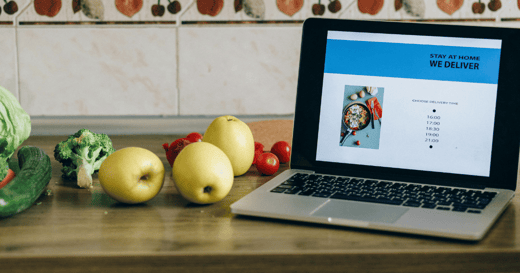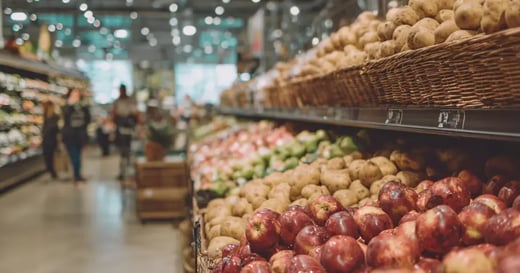Fresh produce sales are on the rise — increasing almost 20 percent since 2019. If you want to get in on the action and capitalize on these trends, you’re not alone. But produce shop and natural store operations aren’t all sunshine and rainbows.
From slim profit margins to fickle suppliers to food safety regulations, running a produce shop is harder than it looks. Even veteran grocery store owners struggle with inventory, pricing, and managing those giant willful mounds of leafy greens and squash.
In this post, we'll highlight the top five headaches for produce shop owners — and how you can tackle them to keep your store running smoothly.
Opening a Produce Shop: Is It Profitable?
One of the first things any entrepreneur needs to consider before starting their business is… is this business profitable? And so, before we examine the challenges of opening a produce shop, let’s first answer a critical question: Are produce shops profitable?
Related Read: How Grocery Store Inventory Leads to Increased Profits
The short answer is… it depends. Produce shops can absolutely be profitable when you approach them the right way. When setting up shop, you should consider a few factors impacting your store’s profitability, including:
- Market Demand and Trends
- Profit Margins and Pricing
Crunch the numbers on projected profit margins for different types of produce you may sell. Consider pricing strategies to attract customers while ensuring you can sell items profitably.
- Operating Costs and Overheads
Add up expected operating expenses, including rent, utilities, inventory, staff wages, supplies, and other recurring costs. Get clear on your break-even point and overhead to determine what sales volume you'll need to turn a profit.
- Seasonality and Inventory Management
Produce availability and pricing fluctuate a lot throughout the year. Develop plans to manage seasonal changes in supply levels and prices to minimize waste. Smart inventory management is crucial to your store’s success
- Technology and Operational Efficiency
Look into retail tech solutions like inventory management software and point of sale (POS) systems to streamline operations and help manage your business. Leveraging technology can optimize operations, reduce human error, and boost profitability.
- Regulatory Compliance
Finally, don't forget about relevant regulations and compliance standards around food safety, labeling laws, etc. Build these costs into your business plan as needed to mitigate any risks down the road.
Evaluating all those elements will give you a clear sense of the true profit potential and viability of running a produce shop in your area. With this in mind, we’re now ready to examine the most common challenges of opening a produce shop.
1. Selecting the Right Location
Location is critical for any brick-and-mortar business, and your produce shop is no different. Your storefront’s location is one of the most important decisions you’ll make when opening your produce shop. How can you select the right location for your store?
Start with research. Analyze neighborhoods or locations with high densities of health-conscious shoppers. Try to find a location with a high concentration of your ideal demographics and a shortage of other stores offering fresh produce.
You will also want to consider accessibility and parking when choosing your storefront. Prioritize locations with easy parking access and visibility to capture commuters on their way home from work or locals running other errands. Of course, consider all these factors and weigh them against the cost of various storefronts in your desired area. Consider both the lease price and other ongoing costs, like utilities and insurance.
Related Read: ANSWERED: How Much Does It Cost To Open a Grocery Store?
Finally, take a look at the neighboring businesses. Ensure you select a location far enough from competitors for your business to stand on its own in the market, but also consider like-minded businesses. Positioning your store near a juice bar or a gym can be advantageous as you will likely have many cross-over customers with those businesses.
2. Finding Quality Suppliers
Another challenge you may face when opening a produce shop is finding the right suppliers. Suppliers are essential to your shop’s success because, without fresh, high-quality produce, you won’t have anything to sell in your shop. How can you find the best suppliers for your store?
Related Read: How To Improve Vendor Relationship Management in 4 Steps
Start by building relationships and partnerships with local farmers, co-ops, or wholesale markets in your area. Require any farmer or business you choose as a supplier to offer you a transparent view of their growing and harvesting processes. This way, you can offer certified organic and ethically sourced produce in your store.
However, your process doesn’t end when you select suppliers. You should constantly evaluate produce quality, ensuring optimal flavor, texture, ripeness, and shelf life. Make contingency plans with backup vendors to ensure you can always stock your shelves, even during seasonal shifts, climate events, or shipping delays.
3. Hygiene and Handling
You want your products to be high-quality, but that doesn’t stop at your suppliers. Another challenge many produce shops face is managing hygiene and product handling in their stores. How can you ensure that your store is up to par with hygiene standards?
Train all customer-facing staff extensively on produce safety fundamentals per the FDA Food Code and State regulations. Validate their skills in mastering proper procedures via written evaluations, emphasizing cleaning and sanitization, preventing cross-contamination, maintaining temperature controls, and documenting compliance with FDA standards.
You should also implement protocols and checklists to ensure proper storage, display, and waste management practices across departments in your shop. To prevent cross-contamination, provide dedicated cleaning tools for different surface areas and residue types.
You should also control access to restricted zones like cutting rooms or storage coolers, clearly communicating handling instructions through store signage.
4. Minimizing Shrinkage Due to Spoilage
Produce shops are all about perishable products. As a result, spoilage is a major concern for business owners in the produce space. As a result, strong inventory management and control processes are essential to your success.
Monitor your inventory carefully. Are certain products slower-moving and more prone to on-shelf spoilage than others? You should also implement a FIFO (first in, first out) inventory management process to encourage sales of older stock before fresher stock. You can make these processes easier and more efficient by leveraging a robust point of sale system.
A strong POS solution allows you to record expiration dates, track historical sales, and forecast demand based on sales trends and history. You can also use a modern POS solution, like IT Retail, to automate reorder alerts, setting thresholds of stock at which to reorder bestselling items to ensure you never run out of stock, while also avoiding overstocking products that may spoil before selling.
Mitigate the losses from expiring products by offering discounts on items nearing their expiration dates to encourage customers to pick them up. You can also partner with local charities and donation programs to minimize the waste from expiring products. The bonus here is that you benefit your community, build trust with your local customers, and gain tax benefits at the same time.
5. Complying With Quality Control Regulations
Finally, many produce shops struggle to comply with quality control regulations and requirements. To keep your store open and compliant, you must stay up to date on all local, state, and federal regulations related to food safety and quality standards.
First and foremost, before you open your produce shop, ensure you obtain the proper licenses, permits, and certifications required to handle and sell fresh produce in your area. You may also want to maintain memberships in trade organizations like the Produce Marketing Association. These organizations provide guidance navigating complex legal standards and best practice implementation across recall procedures, supply chain transparency mandates, refrigeration advisories, and labor statutes.
To comply with regulations and requirements, you must properly label your products, including expiration dates and country of origin. Invest in a custom label printer that integrates with your point of sale system to simplify and streamline this process.
Finally, regularly conduct self-audits and inspections to ensure your staff meets all requirements consistently. This practice helps ensure high-quality practices in your store, maintains customer trust, and sets you up for success in the face of an external audit or inspection.
Manage Your Produce Shop With the Right Tools
Mitigating these five challenges can help you open a thriving produce shop — securing an ideal location and stocking your shelves with fresh, quality fruits and veggies is certainly crucial. But don't overlook the importance of implementing the right technology as well.
Having a robust point of sale system in place is critical if you want to manage your store efficiently and effectively. With IT Retail's grocery and specialty market POS, you can easily track inventory, digitize promotions for seasonal items, set up mobile and self-checkout options, establish customer loyalty programs, and access real-time data with custom reports.
Schedule a demo of IT Retail today to see how our solution can help you manage your produce shop with ease.







 by Margaret Thacker
by Margaret Thacker


